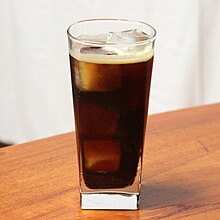Fernet
Fernet is made from a number of herbs and spices which vary according to the brand, but usually include myrrh, rhubarb, chamomile, cardamom, aloe, and especially saffron,[1] with a base of distilled grape spirits.
The Italian liqueur Fernet-Branca, developed in 1845, has a cult following in the international bartending community and is immensely popular in Argentina and Southern Brazil.
[2] Argentina consumes more than 75% of all fernet produced globally[3] and, due to the product's popularity, also has Fratelli Branca's only distillery outside of Italy.
[4] It is particularly associated with Córdoba Province, which has been called "the world fernet capital"; almost three million litres are consumed there annually, representing just under 30 percent of national consumption.
[4] By the early 2010s, the popularity of relatively inexpensive fernet was so high that many bars in Buenos Aires removed it from their menus to encourage sales of more expensive drinks.
[15] Fernet-Branca forms the titular subject of James Hamilton-Paterson's 2004 novel of Tuscany expatriate life, Cooking with Fernet Branca.

